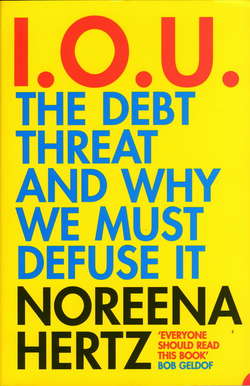Читать книгу IOU: The Debt Threat and Why We Must Defuse It - Noreena Hertz - Страница 12
Under their thumbs
ОглавлениеJust think how such naked self-interest could be interpreted by the borrower country’s people. In many cases, these people never got any benefits from the monies borrowed, either because the loans were used by despots to retain their internal power base or because they were unwisely spent. And then add this: the thought of how easy it is to interpret debt as a tool of subjugation, whereby countries are kept in debt specifically to keep the weak weak, the poor poor, the powerless powerless, not only to maintain pre-existing social and economic hierarchies but also to strengthen and reinforce them – something Mao Zedong, as we saw, so clearly feared.
Countries are usually only given debt relief if, as we will see, they conform to the rich world’s own set of rules. Creditors are allowed to negotiate en masse, while the articles of the Paris Club explicitly deny that right to borrower countries. The US Treasury did not even consider providing Nicaragua and Honduras with debt relief in the wake of Hurricane Mitch in 1998, Treasury Department officials actually admitting at the time that ‘loss of leverage’ was their reason for refusing to consider comprehensive debt cancellation for the two countries. The United States decided in July 2003 to withhold military aid from countries which refused to exempt American soldiers from prosecution by the International Criminal Court. Many examples seem to give this interpretation credence. But the extent to which this interpretation is accurate is almost beside the point. The fact that debt can so easily be interpreted in this way creates very real problems of its own. Problems that, as we will see in later chapters, can harm all of us, wherever we are.
For using debt as a highly effective mechanism of control will only serve to engender discontent in the very countries where the West seeks to exert influence, particularly given the heavy-handed way in which the lender often displays his dominance. When Yemen, for example, voted against UN Resolution 678 which authorized the first Gulf War, a senior US diplomat commented on the occasion, ‘This will be the most expensive “no” vote you have ever cast.’ A $70 million US aid project for Yemen was subsequently cancelled. This despite the fact that Yemen was (and remains) one of the world’s most highly indebted poor countries, and that life expectancy was only 46. Not unsurprising, then, that there were very large anti-American demonstrations in Yemen in 1991 and the US embassy was attacked with small arms fire.
So we begin to unpack the story of developing world debt. And what an unsavoury chapter this one has been proven to be. It is true that there are a few cases where countries have tended to lend for relatively altruistic or disinterested purposes (Finland and the Netherlands spring to mind), but any general interpretation of lending to developing countries as being primarily motivated by a desire to help Kennedy’s ‘struggling’ masses would clearly be naive. For the story behind country-to-country lending is on the whole neither one of altruism, nor even of enlightened self-interest. The self-interest is more usually myopic. The altruism is missing.
While it is true that in some cases, whatever motivated the lender, loans did result in high economic and social returns, all too often the outcome was one of bad guys getting benefits while the poor, marginalized and vulnerable saw very little of the spoils.
As we have seen, some developing countries who could afford to, have taken a stance against borrowing. Some others have had no choice and on occasion have used the loans for productive investment, but the majority have taken what they could get from the eagerly proffering superpowers. As a result, most of them, after the end of the Cold War, are mired in impossible levels of debt repayment that profoundly damage their country’s well-being. The lenders, for their part, not only provided the means, and sometimes the weapons for internal and external wars, they also provided the means to shore up dictatorships and corruption in pursuit of immediate national security concerns.
This chapter has been the story of reckless borrowing and of profligate lending, the antithesis of a rational process of lending and borrowing where a loan is requested and granted in circumstances where it is believed that the investment will produce enough money both to pay off the debt and generate self-sustaining economic growth. It is also the story of a complete failure to understand long-term security considerations. The slashing of aid to the world’s poorest countries after the end of the Cold War, for example, under the misconception that this signalled the end of an era of high security risks, has undoubtedly played a contributory role in creating the insecure world we all now inhabit.
The short-sighted decisions created by geopolitical considerations devoid of humanity – or even intelligent self-interest – are a crucial component in the building story of the debt threat.
